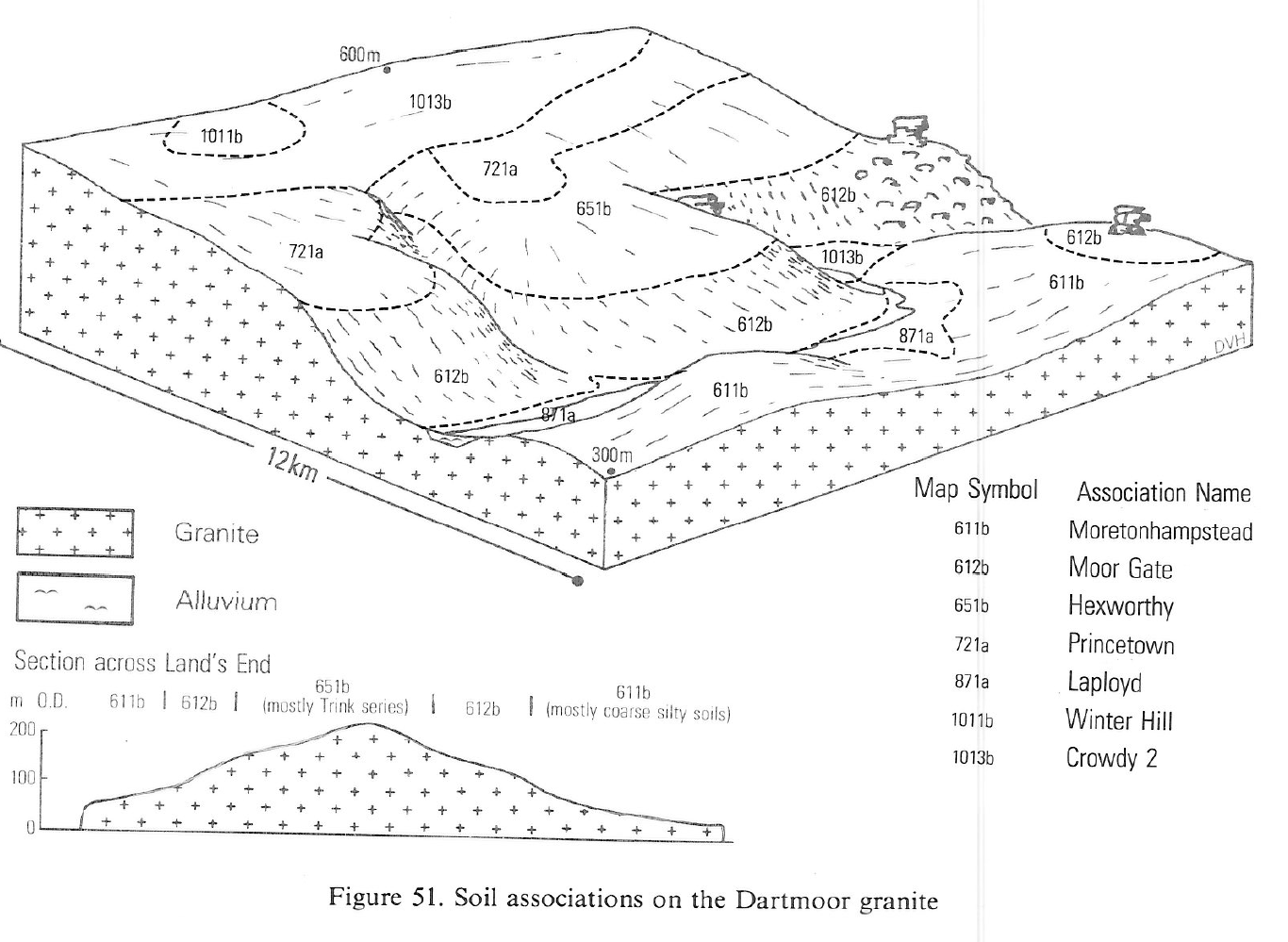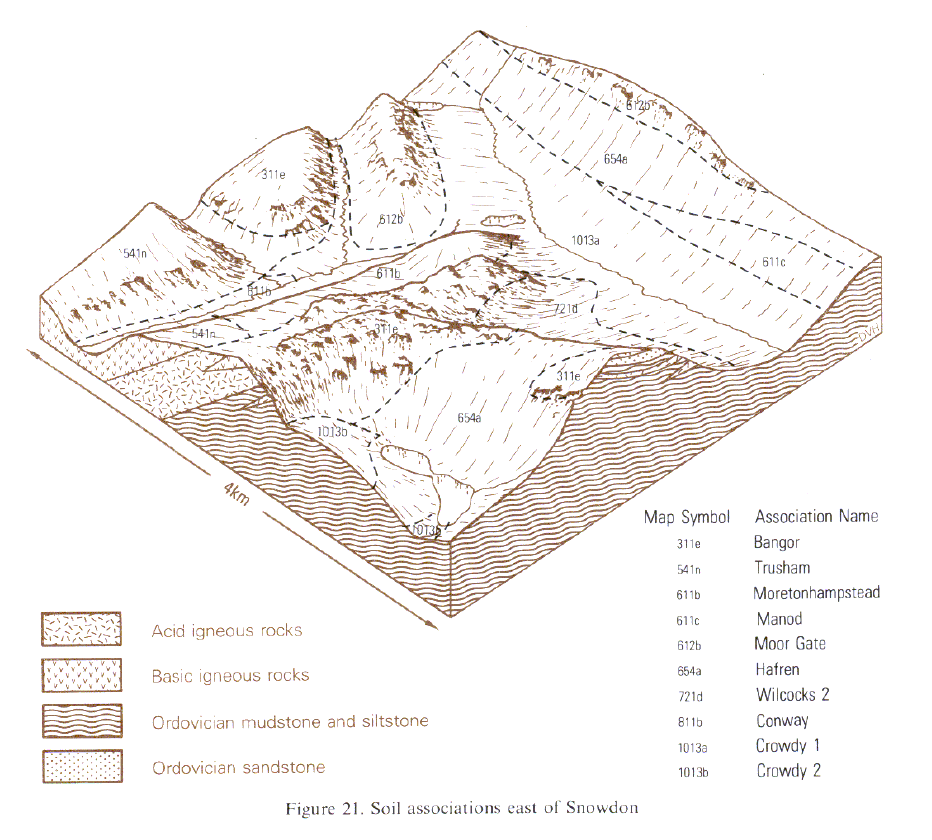
Soil Associations
0611b MORETONHAMPSTEAD
Soil and site characteristics
Well drained gritty loamy soils with a humose surface horizon in places. Some steep slopes. Boulders and rock locally.
Geology
Granite and other acid igneous rock
Cropping and Land Use
Stock rearing in uplands on permanent grassland and some moorland of good grazing value; coniferous woodland; dairying some early potatoes and broccoli in West Cornwall.
Component soil series
| Subgroup | Series name | Percentage | WRB 2006 link |
|---|---|---|---|
| 6.11 | MORETONHAMPSTEAD | 85% | Chromic Mollic Endoskeletic Umbrisols |
| 6.12 | MOOR GATE | 10% | Humic Endoskeletic Umbrisols |
Covers 588 km2 in England and Wales
Soilscapes Classification
| 13 |
Freely draining acid loamy soils over rock |
0611b MORETONHAMPSTEAD
Detailed Description
The Moretonhampstead association covers 550 km² and consists of well drained podzolic soils over acid igneous rocks. In South West England and the Lake District the parent material is a gritty, sometimes bouldery, granitic Head passing down into deeply weathered and weakly coherent granite. Hard rock is exposed in places as tors and buttresses and adjacent slopes are often strewn with granite blocks. In Wales the bedrock is more varied and, while acid igneous rocks such as rhyolite predominate, basic and intermediate rocks and intervening bands of sedimentary rock are also included. In north Wales rhyolite is the major parent rock and screes are common. Coarse loamy typical brown podzolic soils, Moretonhampstead series, usually occupy about two-thirds of the land, with similar but coarse silty soils. Humic brown podzolic soils of the Moor Gate series are important associates. In Wales the various associated sedimentary and igneous rocks other than granite give predominantly well drained soils including Denbigh series over slates and mudstones, Trusham series on basic igneous rocks, and Meline and East Keswick series on drift. Brown earths of the Gunnislake series have also been included. Minor soils in north Wales include the Bangor series, with wetter soils in flushes.
In west Cornwall the granite Head, known locally as growan, is overlain by silty aeolian drift to give siltier soils which predominate south west of Penzance, but become less important eastwards. Moor Gate and Cucurrian soils are found on steep slopes or bouldery ground where agricultural improvement is not possible. On Land's End and the Isles of Scilly intense cultivation over a very long period has produced thick dark topsoils, many qualifying as man-made soils.
The association is found in lower Eskdale and Ennerdale, in the western Lake District. The land is craggy and generally steep, although often undulating below about 200 m O.D. There is no distinctive pattern of soils, because of irregular variations in the drift. Trusham series is found where land has been taken into permanent grassland.
Soil Water Regime
The soils are well drained (Wetness Class I) and in most circumstances they absorb winter rain with ease. On steep slopes there is some surface run-off. The soils are slightly droughty under grass in extreme south-west Dyfed and non-droughty for barley. Although harvested in June, early potatoes are commonly irrigated.
Cropping and Land Use
In the lowlands of south-west Dyfed arable and some horticultural crops are grown, whereas in the uplands grassland farming predominates. Where cultivation is not prohibited by slope or boulders, the soils are easily worked over a range of soil moisture contents and, although opportunities for landwork are few, the soils are commonly ploughed in winter as it allows maximum use of grass in autumn and limits weed growth during the mild winter weather. Specialized crops such as early potatoes and broccoli are grown in south-west Dyfed on ground relatively free from spring frosts. The commonest cereal crop is spring barley. Inland where rainfall is high, grassland and rough grazing of good and moderate value is widespread. On steep and rocky slopes where access is restricted bracken is common. The soils are well-suited for forestry in sheltered sites. Douglas fir and Japanese larch are favoured on the lower ground, while Sitka spruce succeeds well under higher rainfall. There is semi-natural oakwood in many steep-sided valleys providing rich wildlife habitats.
The association represents most of the enclosed land on granite in Devon and Cornwall, over which there is considerable climatic range. West Cornwall and the Isles of Scilly have significant arable and horticultural cropping but on Bodmin Moor and Dartmoor grassland farming predominates. Where cultivation is not limited by slope or boulders, the soils are easily worked over a range of soil moisture. Though conditions are drier in the autumn and winter cereals are grown in sheltered parts, spring cultivation for arable crops is often carried out with little damage to soil structure. The mild climate of the extreme south-west allows the production of early potatoes and broccoli on sheltered ground on the Land's End peninsula, and narcissi and potatoes on the Isles of Scilly. Many topsoils in these areas have been modified by long term addition of seaweed and by deep cultivation. In west Cornwall, where the soils are slightly droughty for grass, dairying is sometimes on a rotational system with horticultural crops. Under the higher rainfall of the moorland fringe, the soils are better suited to grassland though steep slopes and bouldery ground limit access and some pastures are infested by bracken and provide only rough grazing. Forestry is important on the drier parts of eastern Dartmoor. Steep slopes unsuited for agricultural use provide sheltered sites for Douglas fir and Japanese larch with Sitka spruce where rainfall is higher. Oakwoods clothing many valley sides were formerly coppiced but now provide rich wildlife habitats and some have been set aside as nature reserves.
Forestry Commission land at Ennerdale and Blengdale has Sitka spruce, Norway spruce, Corsican pine, Douglas fir and Japanese larch. Steep slopes necessitate hand planting and cable crane extraction. There is some deciduous woodland, particularly around Muncaster Castle, which has mature oak, ash and beech with an understorey of rhododendrons and magnolias.
0611b MORETONHAMPSTEAD
Distribution Map
 |
Note that the yellow shading represents a buffer to highlight the location of very small areas of the association.
Keys to component soil series
Wales
 |
South Western Region
 |
Northern Region
 |
Typical Landscapes
South Western Region
 |
Wales
 |
Wales
 |
All information Copyright, Cranfield University © 2024
Citation: To use information from this web resource in your work, please cite this as follows:
Cranfield University 2024. The Soils Guide. Available: www.landis.org.uk. Cranfield University, UK. Last accessed 26/04/2024
